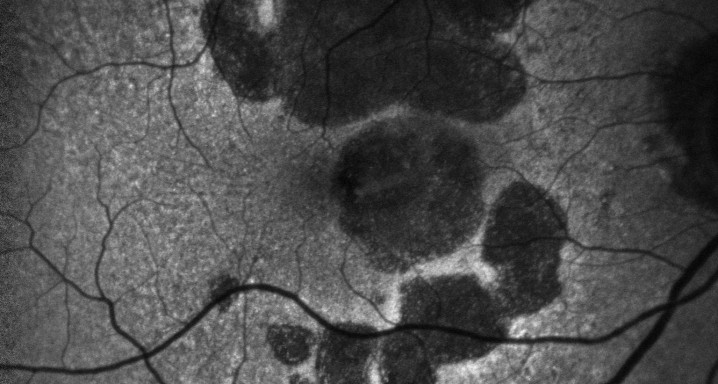Hyporeflective wedge-shaped band in geographic atrophy secondary to age-related macular degeneration: a little-understood spectral domain optical coherence tomography finding. 26/03/2013

OBJECTIVE:
To describe and interpret the frequently observed spectral-domain optical coherence tomography (SD-OCT) finding of a marked hyporeflective wedge-shaped structure at the boundaries of the areas of atrophy.
DESIGN:
A prospective, longitudinal follow-up study.
PARTICIPANTS:
Consecutive patients (n = 71) 50 years of age and older with geographic atrophy (GA) secondary to age-related macular degeneration (AMD) were examined between January 2010 and June 2011.
METHODS:
Patients were evaluated with the use of imaging techniques that included 35° fundus photography, infrared, fundus autofluorescence (FAF), and SD-OCT. Visualization of the fundus with FAF was done simultaneously with OCT. Two acquisition protocols were followed: a macular cube for coverage (19 horizontal B-scans centered on the fovea) and high-resolution horizontal B-scan for qualitative foveal detail.
MAIN OUTCOMES MEASURES:
Estimation of the prevalence of a hyporeflective wedge-shaped band among patients with GA.
RESULTS:
A marked hyporeflective wedge-shaped structure, with its base on Bruch's membrane and its apex pointing toward the inner limit of the outer plexiform layer (OPL) adjacent to the margin between the atrophied area and the preserved retina, was observed in 72.9% of eyes (70/96; 95% confidence interval, 63.9-82.0). This hyporeflective band appeared to be within the OPL. Using eccentric SD-OCT acquisition, the boundaries between the outer nuclear layer (ONL) and Henle's fiber layer (HFL) were well defined, showing that the ONL ends before the margin of atrophy of the retinal pigment epithelium (RPE). A narrow hyperreflective band separated the margin of the ONL and RPE from the hyporeflective band, already within the atrophic area.
CONCLUSIONS:
A hyporeflective wedge-shaped structure appears frequently within the boundaries of the OPL in patients with GA secondary to AMD, corresponding to an increase in the width of the HFL, presumably because of axonal swelling or interaxonal edema. This finding may improve the interpretation of SD-OCT images of the outer layers, may help in understanding better the interactions between photoreceptor cells and the RPE, and may help in the development of monitoring techniques and therapies for GA secondary to AMD.
DMAE seca o atróficaRetinografíaAutofluorescenciaAngiografía fluoresceínicaMicroperimetríaTomografía de coherencia ópticaAngiografía con verde de indocianina









